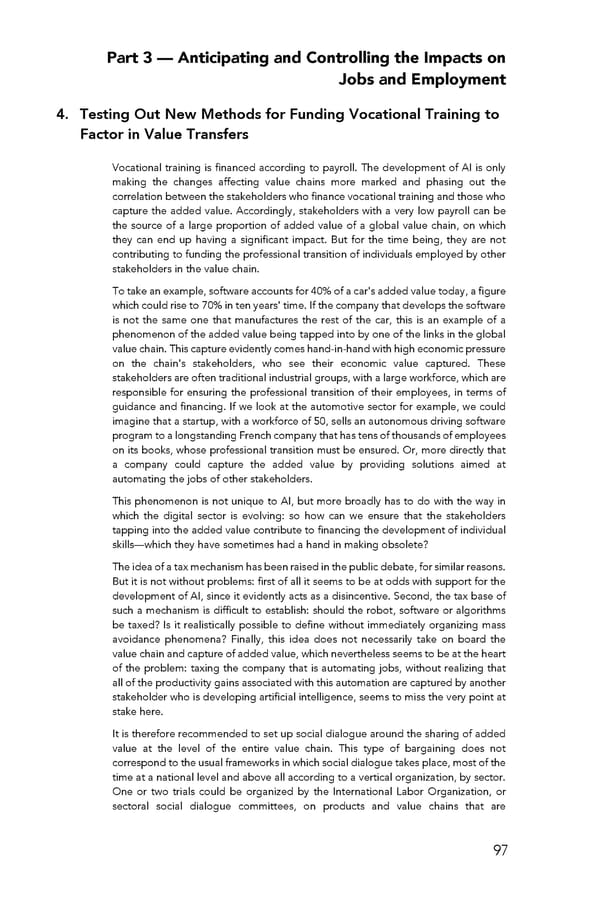Part 3 — Anticipating and Controlling the Impacts on Jobs and Employment 4. Testing Out New Methods for Funding Vocational Training to Factor in Value Transfers Vocational training is financed according to payroll. The development of AI is only making the changes affecting value chains more marked and phasing out the correlation between the stakeholders who finance vocational training and those who capture the added value. Accordingly, stakeholders with a very low payroll can be the source of a large proportion of added value of a global value chain, on which they can end up having a significant impact. But for the time being, they are not contributing to funding the professional transition of individuals employed by other stakeholders in the value chain. To take an example, software accounts for 40% of a car's added value today, a figure which could rise to 70% in ten years' time. If the company that develops the software is not the same one that manufactures the rest of the car, this is an example of a phenomenon of the added value being tapped into by one of the links in the global value chain. This capture evidently comes hand-in-hand with high economic pressure on the chain's stakeholders, who see their economic value captured. These stakeholders are often traditional industrial groups, with a large workforce, which are responsible for ensuring the professional transition of their employees, in terms of guidance and financing. If we look at the automotive sector for example, we could imagine that a startup, with a workforce of 50, sells an autonomous driving software program to a longstanding French company that has tens of thousands of employees on its books, whose professional transition must be ensured. Or, more directly that a company could capture the added value by providing solutions aimed at automating the jobs of other stakeholders. This phenomenon is not unique to AI, but more broadly has to do with the way in which the digital sector is evolving: so how can we ensure that the stakeholders tapping into the added value contribute to financing the development of individual skills—which they have sometimes had a hand in making obsolete? The idea of a tax mechanism has been raised in the public debate, for similar reasons. But it is not without problems: first of all it seems to be at odds with support for the development of AI, since it evidently acts as a disincentive. Second, the tax base of such a mechanism is difficult to establish: should the robot, software or algorithms be taxed? Is it realistically possible to define without immediately organizing mass avoidance phenomena? Finally, this idea does not necessarily take on board the value chain and capture of added value, which nevertheless seems to be at the heart of the problem: taxing the company that is automating jobs, without realizing that all of the productivity gains associated with this automation are captured by another stakeholder who is developing artificial intelligence, seems to miss the very point at stake here. It is therefore recommended to set up social dialogue around the sharing of added value at the level of the entire value chain. This type of bargaining does not correspond to the usual frameworks in which social dialogue takes place, most of the time at a national level and above all according to a vertical organization, by sector. One or two trials could be organized by the International Labor Organization, or sectoral social dialogue committees, on products and value chains that are 97
 For a Meaningful AI - Report Page 97 Page 99
For a Meaningful AI - Report Page 97 Page 99